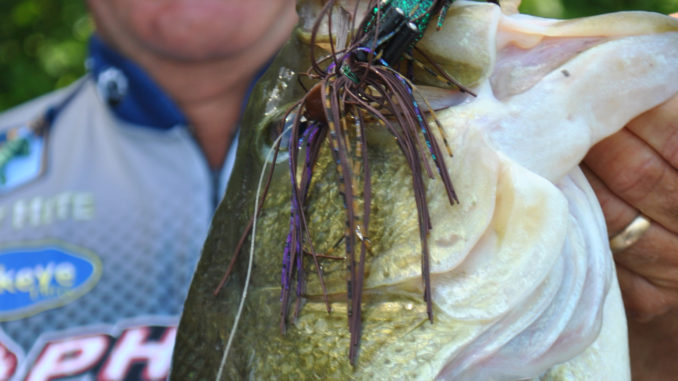
To find prespawn staging areas, look for cover
March means prespawn bass fishing across South Carolina, with maybe a few fish spawning late in the month, but it’s the best prespawn month and big-fish month. And it’s not only great for big fish, but for good numbers of fish, too, because you can often find fish ganged up in staging areas.
Bass pros talk a lot about staging areas, and while they are special places to catch fish, they’re not mysterious places that you can’t identify just by moving across them with your depth finder. They are nothing more than places where bass stop and spend time before moving up onto spawning flats.
Typically, staging areas are places in water that’s slightly deeper than the flats where they spawn. If you’re fishing a clear lake where bass spawn in 4 or 5 feet of water, the staging spots might be 10 to 15 feet deep. If you’re fishing a stained lake where they’re spawning in 2 or 3 feet of water, they might be staging 5 or 6 feet deep. There might be a little contour break close by, maybe as little as 2 feet, but what is most important is that there’s cover in the area. It might be a dock that hangs out over deep water, a brush pile, three or four stumps in the right place, maybe a hundred yards of riprip, maybe just one Christmas tree; the cover is what attracts the bass. The right kind of cover will attract groups of fish.
When bass stage, they move up out of deep water, and they sit there and wait for their eggs to mature, for the water temperature and the moon to get right, then they move in to spawn. What makes finding one of these staging areas so great is that you might catch fish on them for weeks. The spawn in Florida — where I’m heading right now for our Bassmaster Elite tournament on the St. John’s River — might be spread out from late December through April, but our spawn in South Carolina is usually the last part of March, all of April and a week or so in May. Throughout that time, you’ll have different groups of fish moving up into staging areas, then going in to spawn; they don’t all go up at once.
If you’ve really found a good staging area, you might catch fish there one day, then go back the next day, or the next week, and catch fish from another group that has moved up. But keep in mind, especially if you’re getting ready for a tournament, that you can’t pound on ’em one day in practice and not expect that to hurt you the next day.
I put my trolling motor down and try to cover a lot of water outside of flats where I expect bass to spawn, looking for places bass will stage. Depending on the water temperature and depth of the cover, I may use one of three different baits. If the water is in the high 50s, I’ll probably be using a No. 7 Shad Rap. If it’s warmer, then I’ll go with a Rapala DT-6 or DT-10, or maybe a lipless crankbait. When I catch a couple of fish on a crankbait, then I can switch over to my favorite prespawn lure, a 3/8- to 1/2-ounce Mop Jig, a great big-fish bait. While you might be able to catch every bass that’s ganged up on that piece of cover on one of those crankbaits, I just think a jig is a better big-fish bait.
I’ll fish a Shad Rap on a 6-foot-6, medium action Bass Pro Shops cranking rod and a Johnny Morris signature series baitcasting reel spooled with 10-pound XPS fluorocarbon. If it’s real windy, I’ll fish it on a spinning rod. For the DTs, I’ll use a 7-foot BPS cranking rod and a reel spooled with 12-pound XPS fluorocarbon. When I’m fishing a Mop Jig, I’ll go with a 7-foot, medium heavy BPS Carbonlite outfit with 14- to 17-pound XPS fluoro on the reel.
So, don’t think that finding places where bass stage before they spawn requires some kind of mysterious talent exhibited only by pro bass fishermen. Just look in the right areas, for the right kinds of cover, and you may find out they’re not all that special — while being really special.




Be the first to comment